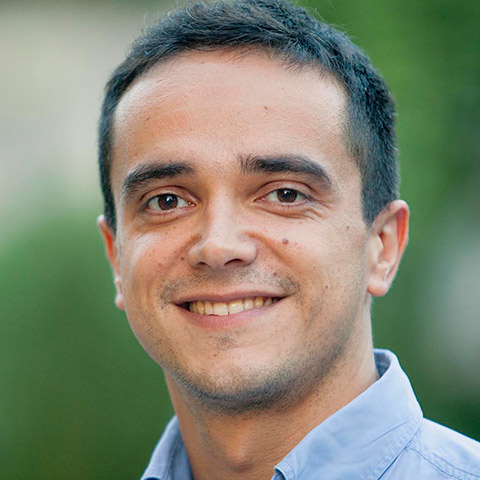The advent of collective self-consumption: the French case
Topic of the Month: Citizens taking the initiative
Collective self-consumption: the French case
by Stefano Verde, Albert Ferrari and Nicolò Rossetto (FSR Energy & Climate)
Topic of the month: Citizens taking the initiative
This third instalment of the Topic of the Month on community-led renewable energy initiatives presents an interview with three experts on the emerging model of producing and consuming electricity known as collective self-consumption (CSC). In the past few years, CSC has attracted much attention because of its potentially relevant social benefits, which would be attained by simultaneously inducing investments in renewable energy and improving the efficiency of the energy system. Our experts, Eugénie Bardin (Enercoop), Marc Gratton (ENEDIS) and Basile Nicolsky (Commission de Régulation de l’Énergie), have followed the process that, in France, has seen CSC becoming the object of public debate and today the matter of regulatory experimentation. Consistent with the different roles of the respective organisations (renewable energy cooperative, distribution system operator and national regulatory authority) in CSC setups, their views offer a variety of perspectives on the issue.
Self-consumption is the act of consuming on the spot all or part of the energy produced. It can be limited to a single site of production and consumption, in which case it is referred to as individual self-consumption, or it can involve a plurality of consumers located in the same building, on the same street or even in the same neighbourhood, depending on the scale of CSC allowed.
Rules already adopted in France for all CSC operations include (among others) a) the requirement of a legal entity binding together the producers and consumers involved, and b) maximum limits to geographical scope and electrical capacity (you can find the French legal norms concerning self-consumption here and here). As with individual self-consumption, key determinants of the economic convenience of the CSC model are the full cost of self-consumed energy (including possible tariffs and taxes) and the own rate of self-consumption, which reflects the extent of matching between production and consumption loads. Crucially, CSC allows for increasing the rate of self-consumption by adding together participants’ different demand and production curves (CRE, 2017).
Accommodating the CSC model in the energy system generally raises challenges – in contrast with renewable energy cooperatives, which are a different type of community and, above all, a subject rather than an activity. The Clean Energy Package has introduced CSC at the EU level through the definitions of “jointly acting renewable self-consumers” (Directive on the promotion of the use of energy from renewable sources, art. 2.15 and 21) and “jointly acting active customers” (Directive on common rules for the internal market for electricity, art. 2.8 and 15), but it is now up to the Member States to specify the terms of CSC in their jurisdictions (Ines et al., 2020; Frieden et al., 2019). Related central questions concern: a) choosing appropriate ways for promoting the CSC model; b) defining cost-reflective network tariffs (i.e. reflecting the impact of CSC on the operation and development of the public electricity network) in conformity with existing tariffication principles; c) delimiting the scope of CSC operations; and d) preserving existing consumers’ rights (CEER, 2019). The development of CSC thus strongly depends on policy and regulatory choices. Of course, other factors may also play an important role. These can be as disparate as the cost of batteries (storage), the future evolution of electricity prices, and citizens’ willingness to take direct action in sustainable energy models.

The interview below explores the emergence of collective self-consumption in the French context.
Is CSC an effective and efficient option for accelerating the energy transition? If yes, how should it be promoted?
Eugénie Bardin (EB): CSC is an effective option for accelerating the energy transition. CSC projects can be particularly effective in empowering citizens and local actors (notably SMEs and local authorities) through ownership of electricity production capacity and social ties. Yet, CSC in France remains niche because it is not economically convenient. Financial incentives need to be strengthened. Key is the remuneration of excess electricity injected into the grid, which should be valued as much as self-consumed electricity. This would probably ensure that CSC operations remain integrated in the public network while also promoting CSC with third-party investment – a configuration incentivising both self-consumption and production. As regards taxes and tariffs, we are certainly in favour of exemptions on local excise taxes, and also consider a) exemptions on the CSPE, which is the levy financing RES support schemes (among other things), and b) a revision of the CSC-specific TURPE (the new optional network tariff for CSC operations), notably, a reduction of the rate paid on withdrawn energy. Under no circumstances, however, should such measures result in a burden on consumers not participating in CSC operations.
Marc Gratton (MG): Under the current rules, CSC projects are usually not economically viable. Thus, as it stands, CSC does not seem cost-effective. CSC project developers are concerned about tax and tariff treatment, but a critical variable is also the perimeter of CSC operations. It does not represent a form of direct support, but it is a determinant of the maximum self-consumption rate that can be achieved, all the more important as getting a revenue from the sale of excess electricity is difficult. The Loi Pacte allowed experimenting on the maximum CSC perimeter, which is now a circle with a 1-Km radius (note: under previous rules, all consumers participating in a CSC operation had to be behind the same low voltage transformation station).
Basile Nicolsky (BN): CSC can be a cost-effective option inasmuch as it results in reduced expansion of the network and, therefore, reduced costs. The energy transition requires major investments in the network, so in theory this aspect of CSC is important. However, its actual significance must be demonstrated. At CRE we think that a network tariff specific to CSC should only reflect the network costs or benefits that can be related to CSC (e.g. the fact of consuming electricity when it is locally produced), but it should not be confused with support mechanisms. Of course, the government may want to promote CSC given its own policy objectives. In that case, we favour forms of direct policy support, such as tenders or feed-in tariffs, rather than indirect support, such as tax exemptions or special network charges, as the former are more controllable and minimise potential windfall effects. Tenders guarantee that financial support is allocated efficiently, whereas all producers benefit from tax exemptions regardless of their own profitability. Also, direct support can be signed for a fixed duration, whereas special fiscal treatment is not guaranteed to cover a project’s whole life.
Do you have any concern about the diffusion of CSC?
EB: A risk is that CSC develops in the form of islands. Conversely, the development of CSC should stay integrated in the public network and conform to existing tariffication principles, including geographical equalisation. Network tariffs applied to self-consumers can be different from those applied to standard consumers, but the difference cannot be disproportionate. The argument of CSC detractors whereby differentiated network tariffs would result in excessively high electricity costs for consumers not participating in CSC operations is a false argument. Energy poverty depends on other factors that should be tackled, such as home insulation. In fact, as we have had the opportunity to observe, CSC can play a role in changing consumer behaviour, making people more attentive to how much electricity they consume.
MG: From the DSO perspective, no particular problems are foreseen. It will be the task of ENEDIS to make sure participants in CSC operations consume electricity from the grid without any problem, meeting their expectations, and that all the consumer data are well protected.
BN: CSC raises different equity questions. Firstly, we need to make sure that consumers have the right to join or leave a CSC operation, so that they are able to protect themselves from the evolution of electricity prices and the partition of energy as determined by the administrator of the operation. Secondly, there is the question of setting fair network tariffs, not placing unjustifiable burdens on consumers that do not participate in a CSC operation.
Which actors in the electricity system will be most affected by CSC?
EB: DSOs have shown strong responsiveness to the topic, probably because historically the French electricity system is very much centralised. More interestingly, perhaps, also thanks to pilot projects in which Enercoop participates, we can clearly see CSC causing changes in the activity of suppliers. The role of suppliers in CSC operations is central, one that requires new types of interaction with other actors.
MG: DSOs are of course directly affected, as they need to make sure that things work as smoothly as possible. It is a technical and organisational challenge – ENEDIS might need a couple of years to fully meet such expectations. Suppliers are also affected. For example, as in a CSC operation each consumer keeps the right to choose her own supplier, suppliers need to know the difference between production and consumption levels. And aggregators will be affected too, for just as any other actor who is in charge of keeping the production-consumption balance, they need information on how the energy load is spread.
BN: DSOs are the first to be affected, as they need to put in place all the necessary contractual, billing and IT infrastructure. Then, consumers taking part to such operations will likely become more reactive in terms of demand response. In turn, this greater engagement of consumers will have implications for the activities of aggregators and suppliers, who are the main counterparts to consumers. Suppliers will be affected because of their balancing responsibility, while aggregators will have the opportunity to show the value of their activity.
How do you expect the diffusion of storage and blockchain to affect the development of CSC?
EB: The diffusion of storage can have a huge impact on the development of CSC, as it means excess electricity can be stored instead of being injected into the grid. However, this should not be the objective of CSC development. In a sense, storage can be dangerous if it leads to isolated CSC operations. But we have no real expectations about such risk.
MG: Storage of course will help increase self-consumption rates – so, good for the profitability of CSC. However, it is to be regarded as complementary to CSC, as people will still need the grid to ensure security and quality of power. Blockchain might play a role, but it is still not clear how exactly it could benefit CSC operations. ENEDIS is working with Sunchain to understand under what conditions blockchain may change things, but there is no real evidence as yet. The role of blockchain will become clearer as CSC projects get bigger, with more participants involved. In such cases, you might need something like blockchain to secure the growing amount of transactions and facilitate scale economies.
BN: Storage can be the propeller for the added value of CSC by reducing peak demand and, thereby, network and generation costs. Blockchain could be used today to help share electricity among CSC participants. In the future, it might even offer an alternative to the traditional supplier scheme, allowing consumers to bypass suppliers. But this will of course depend also on the legal framework.
Today, in France, a key rule is the 1-Km radius delimiting the CSC perimeter. Is this parameter tight, lax or reasonable?
EB: The 1-Km radius seems reasonable. However, as already said, support for CSC remains insufficient.
MG: As DSO we are neutral about these rules. If tomorrow the CSC perimeter is changed, our task is to make things work. However, when it comes to network tariffs, it seems logical that they meet the general principles of tariffication and reflect the reality of the grid – but this is in the regulator’s hands. A CSC-specific network tariff was recently set, but it might be revised later on as currently there is no sufficient evidence on the impacts of CSC projects on the grid. In any case, we need to wait and observe the many CSC projects that have just started or are about to start.
BN: Let me first specify that the 1-Km rule is accompanied by a 3-MW limit for the total power of a CSC operation. Also, it was not the regulator that set these parameters, but the ministry: CRE only has to formulate a non-binding assent. These criteria define an experimental framework until 2023 when it will be reviewed. Under previous rules, the entirety of a CSC operation had to be behind the same low-voltage transformation station. This arrangement was quite constraining, as two consumers could be on the same street but not behind the same transformation station. The new experimental rules allow more CSC operations to be developed and to find profitability. We at CRE do not have a position on what the radius or power limitation should be, as long as the development of CSC operations stays under control. CSC allows consumers to trade locally-produced electricity without being subject to retailing rules, which are there to protect consumers. If there were no geographical limits, it would effectively constitute retailing at large scale. The power limitation guarantees that the scale of CSC operations is not excessively large.
CRE was tasked with setting a CSC-specific network tariff. With the previous definition of CSC (requiring participants to be behind the same transformation station), this was possible because the DSO could allocate its costs between the low and medium voltage branches of the network. Given the demand and production curves of CSC participants, it was then feasible to allocate those costs between energy flows produced locally, which only transit through low-voltage networks, and residual consumption coming from the higher voltage network. With the new definition of CSC, it is not possible to distinguish energy flows in the same way. This is why the optional rate should be available only to those CSC operations that meet the previous definition.
Several CSC pilots are under way in France. So far, what is the experience accumulated telling us?
EB: It is difficult to say with precision how many CSC pilot projects are under way in France, but certainly many more than a dozen, and the number is increasing quickly. In general, the experience so far has been positive. I am particularly familiar with that of Partagélec, in Penestin (Brittany), in which Enercoop is directly involved. There, in the capacity of supplier, Enercoop buys excess electricity at a price higher than the prevailing market price, supporting the project in this way. Based on our experience, the development phase of these projects tends to be the most critical in terms of risks.
MG: The primary concern of CSC promoters is the financial viability of the projects. Especially small promoters, however, often complain about bureaucratic processes whereby, for example, they need to create specific entities only to get the project started. For some, this is not trivial and takes time. The majority of current CSC projects were sponsored or launched by local authorities, which usually are better equipped to tackle these criticalities. But private projects exist too, and they will probably be much more numerous in the future. Real estate and social housing operators – major players interested in CSC – are already tailoring big projects, attracted by the possibilities offered by the 1-Km radius perimeter.
BN: We at CRE have not yet accumulated much practical experience. We observe, however, that no one so far has chosen the optional CSC-specific network rate. I think that people have had difficulty understanding the differentiation between the rate applied to locally-produced energy flows, which is slightly lower than the base rate (as only the low-voltage network is involved), and the rate for flows that systematically come from higher voltage levels, which is slightly higher.
The Florence School of Regulation would like to thank Fondation Tuck for its financial support to the FRESCO project.






